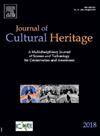威廉·特纳(William Turner)画中的布莱拉(意大利VT)魔鬼桥
IF 3.3
2区 综合性期刊
0 ARCHAEOLOGY
引用次数: 0
摘要
在不断寻找灵感的过程中,威廉·特纳多次前往欧洲,尤其是意大利。意大利的风景,丰富的历史和自然,深刻地影响了他的艺术创作,经常重新出现在他后来的画。在这些旅行中,特纳创作了大量的素描和一些绘画,通常是难以辨认的风景画。其中一幅画是1828年他第二次访问意大利时创作的,暂时被认为是奇维塔·迪·巴尼奥雷吉奥(VT)或皮蒂格利亚诺(GR)的作品。本研究建议根据新的地貌和地形评估来重新审视这些假设,并建议在特纳于1828年访问的图西亚乡村(VT)的另一个地点。这个位置与所有系统比较的特征相匹配,包括绘画的基本组成元素,例如位于类似景观环境中的小道路和桥梁。本文章由计算机程序翻译,如有差异,请以英文原文为准。
The Devil’s Bridge in Blera (VT, Italy) in a painting by William Turner
In his constant search for inspiration, William Turner embarked on numerous trips to Europe, especially Italy. The Italian landscape, rich in history and nature, profoundly influenced his artistic production, frequently resurfacing in his later paintings. During these trips, Turner produced a substantial number of sketches and some paintings, often of landscapes that were difficult to identify. One such painting, created during his second visit to Italy in 1828, was tentatively attributed to Civita di Bagnoregio (VT) or Pitigliano (GR). This study proposes to revisit these hypotheses in light of new geomorphological and topographical evaluations, suggesting an alternative site in the countryside of Tuscia (VT) that Turner visited in 1828. This location matches all systematically compared characteristics, including the painting’s essential compositional elements, such as a small road and bridge, situated in a similar landscape context.
求助全文
通过发布文献求助,成功后即可免费获取论文全文。
去求助
来源期刊

Journal of Cultural Heritage
综合性期刊-材料科学:综合
CiteScore
6.80
自引率
9.70%
发文量
166
审稿时长
52 days
期刊介绍:
The Journal of Cultural Heritage publishes original papers which comprise previously unpublished data and present innovative methods concerning all aspects of science and technology of cultural heritage as well as interpretation and theoretical issues related to preservation.
 求助内容:
求助内容: 应助结果提醒方式:
应助结果提醒方式:


